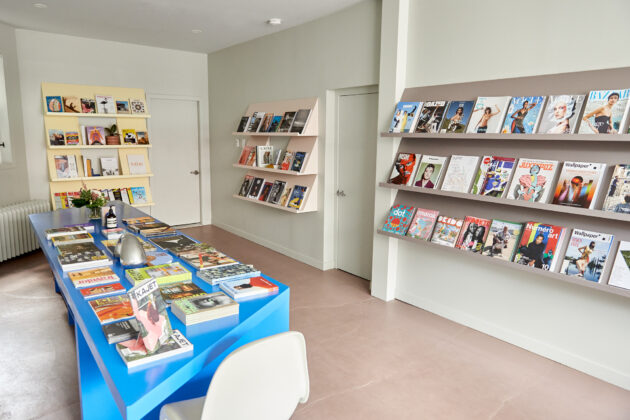
Features
Printing
Magazines still have a home
As newspapers decrease, magazines continue to evolve, reaching and connecting with readers
January 22, 2024 By Olivia Parker
 Nicola Hamilton. Photo © Shlomi Amiga
Nicola Hamilton. Photo © Shlomi Amiga It’s easy for the public to write off magazines when they only know the commercialized ones that line checkout aisles. With the increase in digitalization and reduced production and distribution of newspapers, it is easy to assume magazines could follow the same trajectory, but that is not the case.
Print remains adored by people of all ages. Vividata’s SCC Study of the Canadian Consumer (2023) found that in an average month, 66 per cent of Canadian adults read print or digital magazine content. More importantly, among magazine readers, 42 per cent only read the print version and 17 per cent do so in combination with more than one digital device. Why? In our digital-driven media landscape magazines are refreshing celebrations of independence, niche passions, and creativity.
To better understand how magazines reach and connect with readers I interviewed Dan Thompson from Italic, a print service provider in Toronto, and Nicola Hamilton of Issues Magazine Shop, Toronto.
Print and digital co-exist
Although newsstands have declined, Magazines Canada identifies General Interest and (Other) Niche Publications as two of the best performing genres in 2023. Consequently, around the globe are shops that sell independent publications, including MagCulture Shop in London (U.K.), Casa Magazines in New York, Under the cover in Lisbon, Issues Magazine Shop in Toronto, and Atlantic News in Halifax.
Thompson and Hamilton both highlight the physical enjoyment and tactile experience as a major reason for print’s continued success.
Hamilton points out, “We’re still really wired to absorb information that is in print.”
Although digital devices have decimated our attention spans, print magazines combat screen fatigue and free us from the continuous onslaught of digital notifications.
Thompson echoes the sentiment. “[Print is] the most efficient media format ever invented. It doesn’t need a battery. It doesn’t take any internet bandwidth. It lasts forever. It is one of the only media types that will last the ages because [it is] not in a format that technology will forget about as it advances,” he says.
It is a medium that one engages with intentionally. There is no clickbait. Ironically, independent publication production and readership have grown because of the internet.
The world wide web has enabled people of shared interests to congregate. Communities are no longer hindered by geographic borders to connect. This allows niche networks to organically share ideas and subsequently utilize crowdfunding platforms to support and create passion projects uninhibited by the publishing industry.
“We are seeing it more and more where publishing happens when the money is allocated on a small level…People who have like-minded tastes can then fund it and grow these niche publications out of an idea,” observes Thompson.

Independent magazines that are striving to be different helps set them apart from commercial titles and attract engaged readers. Photo © Sabrina Sisco
A 2016 Pew Research report stated that magazine-related projects made up 20 per cent of all funded projects in the Journalism category on Kickstarter. According to Maris Kreizman, Kickstarter’s former publishing and journalism outreach lead, in 2016, 40 per cent of those projects met their crowdfunding goals. Hamilton points out there are many success stories that highlight how these independent publications offer something different and desired compared to their commercial counterparts. For example, Dan Crowe’s and Matt Willey’s Inque. “They raised £175,000 [on Kickstarter] to create an [ad-free] publication…The goal was to build a literary magazine that would document the decade so it would exist for one issue a year for 10 years and then it would go away forever,” recalls Hamilton.
Another thing to remember is that the digital issue supports growth. While more established titles might still be growing through traditional means, subscribership can also be digitally driven. Thompson sees digital editions as a powerful addition to magazines’ longevity.
“[There exists] this whole idea of digital [issue] to physical then physical back to digital. It’s a really great loop. People leverage the power of print but also leverage the power of the digital magazine versions as well; the magazine exists in both places. You can read it quickly online but then if you want to spend time with the story…you have that option as well to go deeper with the printed piece,” he explains.
Production and distribution
Today, print shops of all sizes continue to print independent magazines. One of the greatest boons for publications has been the technological improvements in digital presses and inline finishing. This has made short-run, high-end production affordable and timely. Thus, enabling small independent publishers and creators to produce gorgeous colour reproductions with high-end finishes. At Italic, Thompson observes, “All those embellishments…are key to making these publications stand out. The readers are buying it sometimes just for those reasons because they want a piece that looks great. They interact with it, and it lasts over time in their home.”
Independent magazines striving to be different (and sumptuous) helps set them apart from commercial titles. This is partially what attracts Hamilton’s clientele.
“Independent publishers are just investing more time [in things] readers actually value, like design and production quality…where[as], I think, over the years commercial titles have prioritized relationships with advertisers.” Independent magazines prioritize interesting concepts, unique designs, and well-rounded editorial.
Once produced there are several ways a magazine can reach its readers. Small to large print shops can use Canada Post to send publications directly to subscribers or they can package them in batches and distribute them through various channels to other end-point destinations.
Hamilton has also observed printers who do a lot of publication design are, in some cases, providing single-copy fulfillment.
Issues employs several methods used to acquire their magazines. First are direct to publisher relationships. Independent titles and publishers may opt for this to keep costs down by cutting out the middle person. Second, are distributors.
“We work with a handful of distributors both here in Canada and abroad. The benefit of a distributor is that you’re managing one relationship for hundreds of titles,” Hamilton explains.
The future
According to Vividata’s SCC Study, Gen Z are more likely to only read print than millennials or Gen X. Gen X are the least likely to read both print and digital, going one way or the other.
Hamilton sees this daily as she has anecdotally shared that Issues clientele are primarily creatives aged 25 to 40 years old.
The desire for community is one of the primary reasons for the longevity of independent magazines. At Issues, “there’s a sort of magic moment where you [find] a publication devoted entirely to [something you are passionate about]…One of our favourite things to witness is when people come in and they find something that speaks to them in some way. They actually hold the title closer to their chest instead of holding it and putting it down.”
Like the book which has not disappeared in the face of digital counterparts, magazines continue to thrive. People value and collect magazines for a myriad of reasons. Whether it is a special issue, the content, or the object itself. The combination of a unique concept or topic and creative execution make these magazines into art objects just as much as editorial collections all while illustrating the communities you belong to. In Thompson’s opinion, “There is a resurgence to get back to analog…like the resurgence of records that have that tactile collector feel. Short-run publications are of the same note. People are missing from their general lives these days something that sits around their house for slow digestible content. Short run and small [are] just what people want whether it’s a lack of local content in a specific market or a real niche interest. These types of jobs are hanging around because they are making an impact in the communities in which they serve.” Never is this more apparent than now with the reduction of accessible local news.
Further, there is trustworthiness in the printed word. While online offers convenience, in our reality of generative AI, digital media is more questionable, and information is harder to vet. Thompson elaborates that “digital information is becoming more and more valueless because we can’t authenticate the source. We are seeing that in spades right now where people are choosing print because it is one of the only channels left that holds authenticity.”
Conclusion
I’d like to close by sharing a final thought from Hamilton. “[Magazines] are things we’re keeping… A lot of people’s energy and effort goes into creating that publication.”
Whether they live on our shelves for a few days or years, magazines are objects of beauty with an innate connection to their readers that, unlike a book with finite pages, continue to release issues and adapt. As cultural artifacts and curated objects, there is so much joy to be found in them. Out there is a magazine for everyone on every subject.
The biggest hurdle is exposure. While newsstands have diminished, the Internet has stepped in to fill that gap. Social media and forums have nurtured a digital-print feedback loop helping readers find their publication and by extension a community. This demand for community is why we are still creating and printing publications and why shops like Issues exist. I encourage everyone to see what’s out there in the stacks. You will be surprised.
Olivia Parker teaches visual communication and media production. She can be reached at olivia.ovp@gmail.com.
This article originally appeared in the November/December 2023 issue of PrintAction.
Print this page

